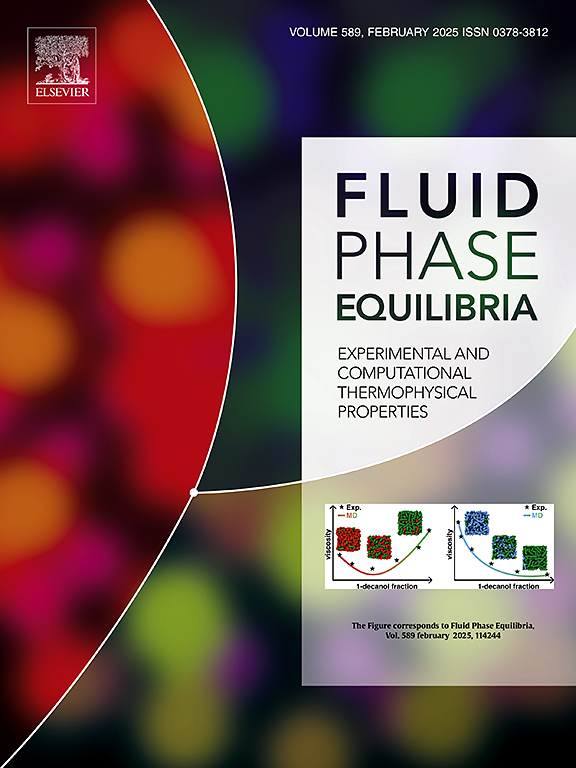Multiscale modeling of dimerization thermodynamics of formic acid
IF 2.8
3区 工程技术
Q3 CHEMISTRY, PHYSICAL
引用次数: 0
Abstract
Heat pumps, which recycle waste heat, are a promising technology for reducing CO emissions. Efficiently using low-grade waste heat remains challenging due to the limitations of standard heat exchangers and the need for more effective working fluids. This work introduces a multi-scale methodology that combines force field-based Monte Carlo simulations, quantum mechanics, and equations of state to explore the potential of formic acid as a new reactive fluid in thermodynamic cycles. Formic acid exhibits dimerization behavior, forming cyclic dimers in the gas phase, which can enhance the thermodynamic efficiency of heat recovery systems. The dimerization reaction of formic acid is crucial because it integrates chemical energy into thermodynamic processes, potentially improving the performance of heat pumps and other energy systems. The study implements umbrella sampling in Monte Carlo simulations to compute the thermodynamic properties of HCOOH dimerization, including equilibrium constants, enthalpy, and entropy. Results from two different methods to study dimer formation, namely the dimer counter method and the potential of mean force method, show strong agreement with the enthalpy of dimerization of −60.46 kJ mol−1 and −62.91 kJ mol−1, and entropy of −137.36 J mol−1K−1 and −146.98 J mol−1K−1, respectively. A very good agreement of the Monte Carlo results with Quantum Mechanics and experimental data validates the accuracy of the simulations. For phase equilibrium properties, the Peng–Robinson equation of state, coupled with advanced mixing rules, was applied and compared to Monte Carlo simulations in the Gibbs ensemble. This approach enabled the determination of the Global Phase Equilibrium of the system, vaporization enthalpy, phase composition, vapor and liquid densities of the coexisting phases, and entropy as a function of temperature. The agreement between the thermodynamic model and Monte Carlo simulations confirms the reliability of the methodology in capturing the phase behavior of the system. The findings demonstrate a promising approach for discovering and characterizing new reactive fluids, contributing to more efficient and sustainable energy technologies.

甲酸二聚化热力学的多尺度模拟
热泵是一种回收废热的有前途的技术,可以减少二氧化碳的排放。由于标准热交换器的局限性和对更有效的工作流体的需求,高效利用低品位废热仍然具有挑战性。这项工作介绍了一种多尺度的方法,结合了基于力场的蒙特卡罗模拟,量子力学和状态方程来探索甲酸作为热力学循环中新的反应流体的潜力。甲酸表现出二聚行为,在气相中形成环状二聚体,可以提高热回收系统的热力学效率。甲酸的二聚化反应至关重要,因为它将化学能整合到热力学过程中,有可能改善热泵和其他能源系统的性能。本研究在蒙特卡罗模拟中实现了伞采样,以计算HCOOH二聚化的热力学性质,包括平衡常数、焓和熵。研究二聚体形成的两种不同方法,即二聚体计量法和平均力势法,结果表明二聚体的焓分别为- 60.46 kJ mol−1和- 62.91 kJ mol−1,熵分别为- 137.36 J mol−1K−1和- 146.98 J mol−1K−1。蒙特卡罗计算结果与量子力学和实验数据吻合良好,验证了模拟的准确性。对于相平衡性质,采用了结合先进混合规则的Peng-Robinson状态方程,并与Gibbs系综的蒙特卡罗模拟进行了比较。这种方法可以确定系统的整体相平衡,蒸发焓,相组成,共存相的蒸汽和液体密度,以及熵作为温度的函数。热力学模型和蒙特卡罗模拟之间的一致性证实了该方法在捕捉系统相行为方面的可靠性。这一发现为发现和表征新的反应性流体提供了一种很有前途的方法,有助于提高能源技术的效率和可持续性。
本文章由计算机程序翻译,如有差异,请以英文原文为准。
求助全文
约1分钟内获得全文
求助全文
来源期刊

Fluid Phase Equilibria
工程技术-工程:化工
CiteScore
5.30
自引率
15.40%
发文量
223
审稿时长
53 days
期刊介绍:
Fluid Phase Equilibria publishes high-quality papers dealing with experimental, theoretical, and applied research related to equilibrium and transport properties of fluids, solids, and interfaces. Subjects of interest include physical/phase and chemical equilibria; equilibrium and nonequilibrium thermophysical properties; fundamental thermodynamic relations; and stability. The systems central to the journal include pure substances and mixtures of organic and inorganic materials, including polymers, biochemicals, and surfactants with sufficient characterization of composition and purity for the results to be reproduced. Alloys are of interest only when thermodynamic studies are included, purely material studies will not be considered. In all cases, authors are expected to provide physical or chemical interpretations of the results.
Experimental research can include measurements under all conditions of temperature, pressure, and composition, including critical and supercritical. Measurements are to be associated with systems and conditions of fundamental or applied interest, and may not be only a collection of routine data, such as physical property or solubility measurements at limited pressures and temperatures close to ambient, or surfactant studies focussed strictly on micellisation or micelle structure. Papers reporting common data must be accompanied by new physical insights and/or contemporary or new theory or techniques.
 求助内容:
求助内容: 应助结果提醒方式:
应助结果提醒方式:


